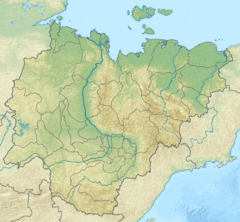Yana (river)
| Yana Яна / Дьааҥы | |
|---|---|
 The Yana flowing past Ust-Kuyga | |
 Basin of the Yana | |
Mouth location in Yakutia, Russia | |
| Location | |
| Country | Russia |
| Physical characteristics | |
| Source | |
| • location | Confluence of Sartang and Dulgalakh |
| • coordinates | 67°27′48″N 133°15′06″E / 67.4634°N 133.2517°E |
| Mouth | |
• location | Laptev Sea |
• coordinates | 71°32′14″N 136°39′11″E / 71.53722°N 136.65306°E |
• elevation | 0 m (0 ft) |
| Length | 872 km (542 mi) |
| Basin size | 238,000 km2 (92,000 sq mi) |
| Discharge | |
| • average | 1,110 m3/s (39,000 cu ft/s) |

The Yana (Russian: Я́на, IPA: [ˈjanə]; Yakut: Дьааҥы, Caaŋı) is a river in Sakha in Russia, located between the Lena to the west and the Indigirka to the east.
Course
It is 872 kilometres (542 mi) long, and its drainage basin covers 238,000 square kilometres (92,000 sq mi).[1] Including its longest source river, the Sartang, it is 1,492 km (927 mi) long.[2] Its annual discharge totals approximately 35 cubic kilometres (28,000,000 acre⋅ft). Most of this discharge occurs in May and June as the ice on the river breaks up. The Yana freezes up on the surface in October and stays under the ice until late May or early June. In the Verkhoyansk area, it stays frozen to the bottom for 70 to 110 days, and partly frozen for 220 days of the year.
The river begins at the
There are approximately 40,000 lakes in the Yana basin, including both alpine lakes formed from
north of about 70°N, though trees extend into suitable microhabitats right to the delta.Verkhoyansk, Batagay, Ust-Kuyga, and Nizhneyansk are the main ports on the Yana.[3]
The Yana basin is the site of the so-called Pole of Cold of Russia, where the lowest recorded temperatures in the Northern Hemisphere are found. In the winter, temperatures in the centre of the basin average as low as −51 °C (−60 °F) and have reached as low as −71 °C (−96 °F); in the mountains it is believed that temperatures have reached −82 °C (−116 °F).[citation needed] Yakut folklore says that, at such temperatures, if you shout to a friend and they cannot hear you, it is because the words have frozen in the air. However, when spring comes the words "thaw" and one can hear everything that was said months ago.[citation needed]
Tributaries
The main
History
Evidence of modern human habitation was found in the delta at the Yana RHS (Rhinoceros Horn Site) as early as 32,000 years ago. These people, designated as "Ancient North Siberians”, genetically diverged 38,000 years ago from Western Eurasians, soon after the Western Eurasians split from East Asians.[5]
In 1633–38
In 1892–1894
See also
References
- ^ "Река ЯНА in the State Water Register of Russia". textual.ru (in Russian).
- ^ "Река Сартанг in the State Water Register of Russia". textual.ru (in Russian).
- ^ a b c Яна, Great Soviet Encyclopedia
- ^ Water of Russia - Яна
- S2CID 91983065. Archived from the original on 1 May 2019.)
{{cite journal}}: Cite journal requires|journal=(help - ^ Lantzeff, George V., and Richard A. Pierce (1973). Eastward to Empire: Exploration and Conquest on the Russian Open Frontier, to 1750. Montreal: McGill-Queen's U.P.
{{cite book}}: CS1 maint: multiple names: authors list (link)
General References
- William Barr, Baron Eduard Von Toll's Last Expedition. Arctic, Sept 1980.
- Alexander von Bunge & Baron Eduard Von Toll, The Expedition to the New Siberian Islands and the Jana country, equipped by the Imperial Academy of Sciences. 1887.

